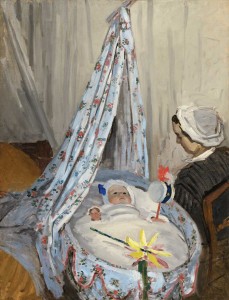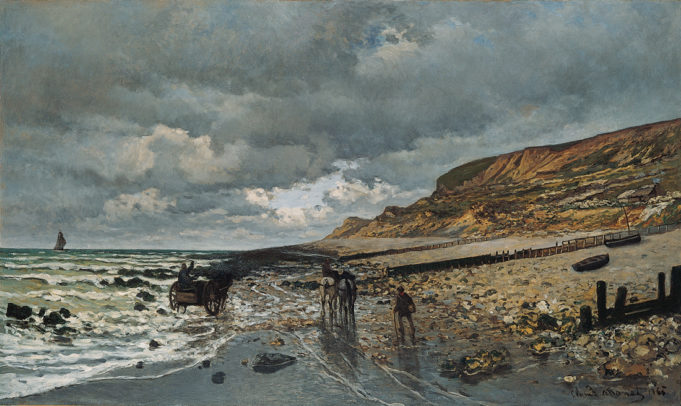If you’re going to put on an art show about Claude Monet at this point, you’d better have something new to say. That’s the challenge facing the Kimbell Art Museum, which opened Monet: The Early Years last week. The exhibit focuses on the Impressionist master before he was a master or indeed before there was such a thing as Impressionism. By narrowing the time frame to before the artist settled in Paris for good, this show limits itself to Monet’s works from his teens and 20s. (It’ll be bookended by a future show about the paintings from Monet’s 80s.) I have to say I didn’t get the thunderbolt of revelation that I expected from this, but I couldn’t help but admire how well-organized the exhibit is.
Monet was born in Paris in 1840, but when he was still a child his parents moved him to the northern port city of Le Havre. Throughout his life he remained fascinated by the challenges of depicting water, and the exhibit opens with his beach painting “The Pointe de Hève at Low Tide,” owned by the Kimbell itself. Painted for exhibition at the Salon of 1865, the picture has a looming, overcast sky that cuts against the popular image of Impressionist art as sunny and welcoming. Off to one side is the cheerier “View Near Rouelles,” an even earlier work by an 18-year-old Monet where you can see evidence of the kid’s technical skill, rendering every leaf on the trees with great clarity in the picture’s bright and sunny landscape.
Still, the most eye-catching piece in the opening part of the exhibit is the gigantic “Luncheon on the Grass,” which is broken into two pieces of different shapes. The odd dimensions of the work are owed to Monet failing to finish it in time for the Salon of 1866 and rolling it up in storage, where a corner of the canvas was ruined. The title is translated from the French original (“Le Déjeuner sur l’herbe”) to avoid confusion with the much more famous Édouard Manet painting by the same title, which caused an uproar only two years before. The piece stands up well enough on its own, showing off the young man’s ambition and ability to capture the play of light through the trees, as well as being a figurative painting from an artist not known for that.

Of course, this side of Monet is shown off to much better advantage in his paintings of his family. He took up with a model named Camille Doncieux despite the strong objections of his father and relatives, and while the young couple lived in terrible poverty, you can still feel Monet’s happiness in “The Cradle,” his painting of his son as a baby, who’s shown being looked over by a woman identified as the boy’s godmother. The floral print on the cloth hanging over the crib and the rattle that the baby is holding add to the picture’s hushed wonder.
The paintings in the exhibit have been collected from such places as the Musée d’Orsay, the National Gallery, the Metropolitan Museum of Art, and far-flung private collections. Were I a curator, I’d be bursting with pride at getting together so many paintings that Monet executed on his easel on the colonnade of the Louvre, each showing different views of Paris from that vantage point. The show also includes sidebars on the paintings he executed in England and the Netherlands, where he spent time partly to avoid the ravages of the Franco-Prussian War of 1870. Casual art lovers may or may not be surprised to find a painting of the windmills at Zaandam (a town known for having lots of those structures) in Monet’s oeuvre, but there’s one here.
I myself was most struck by the three snowy landscapes that Monet painted in Normandy, the centerpiece of which is the d’Orsay’s famous “The Magpie,” where a bird perched on a fence makes a blotch of black against the white background. Monet: The Early Years will doubtless be indispensable viewing for specialists in Monet or Impressionism, but this blockbuster show offers arresting visual experiences for the rest of us as well.












